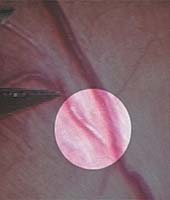BRVO is effectively treated by arteriovenous-crossing decompression
AV-crossing decompression defuses the pathogenic mechanism of BRVO, improving retinal perfusion and resolving intraretinal hemorrhage and edema.
TAORMINA, Italy — Vitrectomy with arteriovenous (AV)-crossing decompression can be an effective treatment in branch retinal vein occlusion (BRVO). Ulrich Mester, MD, at the Jules Gonin meeting here, discussed encouraging preliminary results of the procedure.
BRVO is the second most common vascular disorder of the retina. It usually leads to some degree of visual loss due to intraretinal hemorrhage, macular edema or secondary neovascularization. “Our therapeutic armamentarium, including laser treatment, is effective in preventing severe late neovascular complications and may reduce persistent macular edema in certain cases. However, there is no established therapy for treating persistent macular hemorrhage or ischemia,” Dr. Mester said.
BRVO typically occurs at AV crossings, with the artery crossing over the vein in most cases (70% to 85%). It is postulated that, due to a common adventitial sheath at the AV-crossing, hypertension and arteriola sclerosis narrow the venous lumen, leading to downstream turbulence, endothelial damage and, in certain cases, secondary thrombosis.
“Therefore, surgical dissection of the common sheath at the AV crossing appears to be a logical approach, eliminating the causative factor for BRVO,” Dr. Mester said.
After the presentation of one case of successful surgical decompression by Osterloh and Charles in 1998, Opremcak and Bruce published the results of 15 cases of sheathotomy in 1999.
“I was encouraged by the favorable results of the technique and was convinced by its logical approach. Therefore, in August 1999, I started to perform surgical AV decompression,” Dr. Mester recalled.
Surgical technique

 ---Reperfusion of an
occluded vein can be seen after dissection of the adventitial
sheath.
---Reperfusion of an
occluded vein can be seen after dissection of the adventitial
sheath.
In a prospective, non-randomized study, surgical AV
decompression was offered to all BRVO patients with central, clearly visible AV
crossing, visual acuity of 0.4 or less due to macular edema and extensive
hemorrhage involving the fovea. Selection criteria also involved duration of
symptoms less than 3 months and ineffective hemodilution therapy for at least 2
days.
“Between August 1999 and July 2000, a total of 18 BRVO patients were operated with AV decompression. Nineteen patients who fulfilled the entry criteria but refused surgery served as controls and were treated with isovolemic hemodilution therapy for 10 days,” Dr. Mester said.
As a first stage of surgery, a core vitrectomy was performed. If necessary, posterior vitreous detachment was induced. To carry out these maneuvers, Dr. Mester used Heimann vitreous scissors. Then, an inner retinal incision was made parallel to and slightly under the retinal arteriole with a gentle lifting motion until the common AV crossing sheath was encountered. Using the posterior blade of the scissors, the adventitial sheath was cut, and the artery was separated from the underlying venule. Completion of AV dissection was proven by the elevation of the arteria off the underlying venule.
Positive results
“Surgery was successful in all cases, and no adverse events were reported,” he continued. “In particular, no bleeding occurred during surgery. Postoperatively, no complications have been observed. In some eyes, reperfusion of the occluded vein became visible as soon as the artery was separated from the vein. In most cases, improvement of retinal perfusion could be demonstrated by fluorescein angiography, comparing the preoperative map with the angiographic findings after 1 week. Intraretinal hemorrhage and edema showed marked resolution during the postoperative follow-up.”
Mean VA improved from 0.13 to 0.34 after AV decompression (20 eyes). “Our preliminary results are encouraging. AV-crossing decompression defuses the pathogenic mechanism of BRVO, removing its most serious and common consequences, such as retinal hemorrhage, edema and neovascularization. However, further investigations are needed to confirm the benefits of this new therapeutic approach and to evaluate possible late complications.”
For Your Information:
- Ulrich Mester, MD, can be reached at the Department of Ophthalmology, Bundesknappschafts Hospital, An der Klinik 10, 66280 Sulzbach, Germany; (49) 6897574119; fax: (49) 68975742139. Dr. Mester has no direct financial interest in any of the products mentioned in this article, nor is he a paid consultant for any company mentioned.
